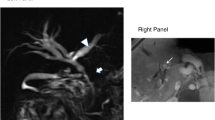Abstract
The purpose of the article was to prospectively evaluate the MR findings of pancreatic portal cavernoma in a consecutive series of patients with cavernous transformation of the portal vein. This study was approved by the review board of our institution, and informed consent was obtained. The clinical and biological data and the MR imaging for 20 patients (11 female, 9 male; median age, 49 years) with cavernous transformation of the portal vein and no evidence of previous pancreatic disease were reviewed. The presence of pancreatic portal cavernoma (defined as intra- and/or peripancreatic portal cavernoma), morphological changes in the pancreas, biliary and ductal pancreatic abnormalities, and extension of the portal venous thrombosis were qualitatively assessed. Fifteen patients (75%) had pancreatic portal cavernoma with collateral formation in the pancreas and/or collaterals around the pancreas seen on dynamic contrast-enhanced MR sequences: three patients had both intra- and peripancreatic portal cavernoma, six had intrapancreatic portal cavernoma alone and six had peripancreatic portal cavernoma only. The presence of intra- or peripancreatic portal cavernoma was significantly associated with extension of the thrombosis to the splenic and superior mesenteric veins (p = 0.05). Morphological changes in the pancreas, heterogeneity on T2-weighted sequences and main ductal pancreatic abnormalities were seen in two, four and two patients, respectively. All these patients had intrapancreatic portal cavernoma. Bile duct dilatation was observed in 13 (65%) patients: among them three had extrahepatic dilatation only and these three patients had associated intrapancreatic portal cavernoma. In patients with cavernous transformation of the portal vein, intra- or peripancreatic portal cavernoma is common. In conclusion, intra- or peripancreatic portal cavernoma was only observed in patients with extension of the thrombosis to the splenic vein and/or the superior mesenteric vein.




Similar content being viewed by others
References
Van Gansbeke D, Avni EF, Delcour C, Engelholm L, Struyvven J (1985) Sonographic features of portal vein thrombosis. AJR Am J Roentgenol 144:749–752
Mathieu D, Vasile N, Dibie C, Grenier P (1985) Portal cavernoma: dynamic CT features and transient differences in hepatic attenuation. Radiology 154:743–748
Ros PR, Viamonte M Jr, Soila K, Sheldon JJ, Tobias J, Cohen B (1986) Demonstration of cavernomatous transformation of the portal vein by magnetic resonance imaging. Gastrointest Radiol 11:90–92
Condat B, Vilgrain V, Asselah T et al (2003) Portal cavernoma-associated cholangiopathy: a clinical and MR cholangiography coupled with MR portography imaging study. Hepatology 37:1302–1308
Vilgrain V, Condat B, Bureau C et al (2006) Atrophy-Hypertrophy complex in patients with cavernous transformation of the portal vein: CT evaluation. Radiology 241:149–155
Ragozzino A, De Ritis R, Guardascione MA, Amitrano L (2003) A portal vein cavernoma mimicking a pancreatic mass. J Hepatol 38:372
Ozcinar B, Ozden I, Bilge O, Emre A, Poyanli A, Okten A (2005) Pancreatic portal cavernoma. JOP 6:40–41
Report of the Expert Committee on the Diagnosis and Classification of Diabetes Mellitus (1997) Diabetes Care 20:1183–1197
Charles MA, Balkau B, Vauzelle-Kervröedan F, Thibult N, Eschwège E (1996) Revision of diagnostic criteria for diabetes. Lancet 348:1657–1658
Bezerra AS, D’Ippolito G, Faintuch S, Szejnfeld J, Ahmed M (2005) Determination of splenomegaly by CT: is there a place for a single measurement? Am J Roentgenol 184:1510–1513
Karasawa E, Goldberg HI, Moss AA, Federle MP, London SS (1983) CT pancreatogram in carcinoma of the pancreas and chronic pancreatitis. Radiology 148:489–493
Ito K, Blasbalg R, Hussain SH, Mitchell DG (2000) Portal vein and its tributaries: evaluation with thin-section three-dimensional contrast-enhanced dynamic fat-suppressed MR imaging. Radiology 215:381–386
Mori H, McGrath FP, Malone DE, Stevenson GW (1992) The gastrocolic trunk and its tributaries: CT evaluation. Radiology 182:871–877
Vedantham S, Lu DSK, Reber HA, Kadell B (1998) Small peripancreatic veins: improved assessment in pancreatic cancer patients using thin-section pancreatic phase helical CT. Am J Roentgenol 170:377–383
Mori H, Miyake H, Aikawa H et al (1991) Dilated posterior superior pancreaticoduodenal vein: recognition with CT and clinical significance in patients with pancreaticobiliary carcinomas. Radiology 181:793–800
Hommeyer SC, Freeny PC, Crabo LG (1995) Carcinoma of the head of the pancreas: evaluation of the pancreaticoduodenal veins with dynamic CT—potential for improved accuracy in staging. Radiology 196:233–238
Bayraktar Y, Balkanci F, Bayraktar M et al (1996) Cavernous transformation of the portal vein is associated with pancreatic duct atrophy. Hepatogastroenterology 43:954–960
Condat B, Pessione F, Hillaire S, Denninger MH, Guillin MC, Poliquin M, Hadengue A, Erlinger S, Valla D (2001) Current outcome of portal vein thrombosis in adults: risk and benefit of anticoagulant therapy. Gastroenterology 120:490–497
Acknowledgement
We are grateful to Martine Blazquez MD, for her help in drawing Figure 4.
Author information
Authors and Affiliations
Corresponding author
Rights and permissions
About this article
Cite this article
Vilgrain, V., Condat, B., O’Toole, D. et al. Pancreatic portal cavernoma in patients with cavernous transformation of the portal vein: MR findings. Eur Radiol 19, 2608–2613 (2009). https://doi.org/10.1007/s00330-009-1459-6
Received:
Revised:
Accepted:
Published:
Issue Date:
DOI: https://doi.org/10.1007/s00330-009-1459-6




